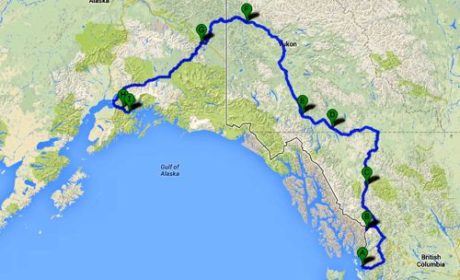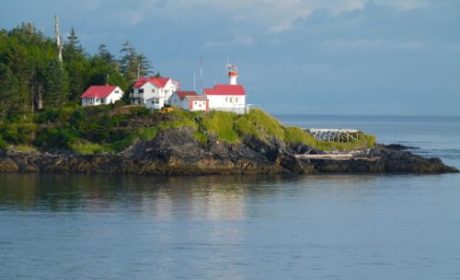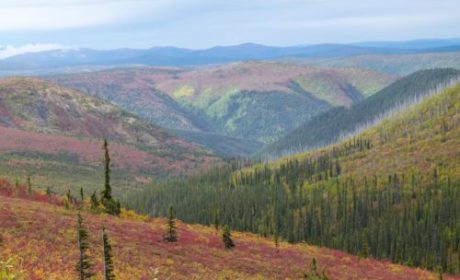Cummins originally sponsored this look at a fall national park road trip from Arizona to the Canadian Rockies. Alan and I consider it one of our best road trips ever!
Are you in the mood for a national park road trip this fall? Here’s a humdinger of an itinerary that takes you from Arizona to the Canadian Rockies based upon a trip that Alan and I experienced.
Table of Contents
Fall National Park road trip itinerary
On this Arizona to Canada drive, we’ll start at the North Rim of the Grand Canyon and end at Banff National Park in western Canada. Traveling in the fall avoids the crowds that you’d see on a summer trip. However, most of the parks—but not all—close their facilities by mid-October, so it’s vital to plan ahead.
Speaking of planning ahead, before leaving on your Western National Park road trip, be sure to follow the tips I wrote for preparing your home for vacation. It’s a long drive back if something goes wrong in your home due to a power outage.

And if you’re driving an RV, check out Cummins RV preparation tips to ensure your RV is ready to take you on this 1800-mile road trip.
To complete this ambitious road trip before the parks gear down for the winter, I recommend spending only 2 to 3 nights at each destination. No, you won’t see everything.
Consider it a buffet of national park travel ideas. Sample a bit of everything to see which parks you’d like to experience in-depth on your next trip.
Now, let’s get started!
Exploring on the edge at Grand Canyon North Rim

On a fall visit to the North Rim of Grand Canyon National Park, golden aspen leaves shimmer in the crisp breeze as you drive through the Kaibab National Forest on the approach to the park. You might see turkey or deer in the meadows bordered by ponderosa pine forest.
On arrival day, grab a seat on the deck of Grand Canyon Lodge for a spectacular sunset followed by a tasty dinner in the lodge restaurant—reservations highly recommended.
Start the next morning on the half-mile Bright Angel Point nature trail for a sunrise photo shoot of the canyon before spending the morning driving Cape Royal Rd to Point Imperial. After lunch, take the 5-mile-loop Uncle Jim trail that travels along the edge of the canyon and into the forest.
Lodging at the North Rim is limited so call ahead. We lucked out with a last-minute reservation in a Frontier Cabin. There is also a campground—no hookups but dump station and water refill station are provided.
Since the North Rim stays open until mid-October, it could be the first or the last national park on this itinerary as most of the other parks close a bit sooner.
Next, we’re headed to Jackson, Wyoming. Yes, we’ll be driving past Zion National Park but there’s only so much time before the snow falls, so let’s continue on to Grand Teton National Park.
Boomer Travel Tip
Gear up with our resources for a fall leaf peeping trip.
Finding fall color at Grand Teton National Park

Autumn blazes gloriously at Grand Teton National Park in Jackson, Wyoming. While admiring the fall colors, watch for elk at the National Elk Refuge.
Be sure to drive the Teton Park Road for grand vistas and to visit the serene Chapel of the Configuration. Another option is to spend a morning hiking to Hidden Falls combined with a boat ride on Jenny Lake.
But we’ve come for fall color, which means an early morning and late afternoon photo shoot at Oxbow Bend. One of the most famous photography sites in Grand Teton.
You won’t be alone when capturing the scene. But seeing golden leaves and Grand Teton peaks reflected into a bend in the Snake River is a magical national park experience.
We acquired a last-minute booking for a log cabin at Signal Mountain Lodge (inside the park). Reserve early for rooms at Jackson Lake Lodge or Jenny Lake Lodge—both lodges close in early to mid-October.
There are numerous campgrounds in Grand Teton National Park. Gros Ventre and Signal Mountain campgrounds stay open until early October.
And now we’re on our way to the third national park on our road trip. Luckily, Yellowstone is just up the road.
Watching geysers spout off in Yellowstone National Park

It’s impossible to see everything on a two-night stay in a vast national park like Yellowstone. To make the most of your time, spend a day exploring the geysers.
Start with a drive to the Upper Geyser Basin where Old Faithful spouts off to a crowd of onlookers. While there, walk the boardwalk to see more thermal features.
Besides the Upper Basin, you’ll want to explore Fountain Paint Pot Trail in Lower Geyser Basin and Porcelain Geyser in Norris Geyser Basin. And don’t miss the pools in the West Thumb Geyser Basin.
If there’s time and the road is open, Grand Canyon of the Yellowstone should be next on your list. Driving the one-way road on the North Rim with stops at four viewpoints provides an introduction to the Grand Canyon. You’ll see the Lower Falls, Upper Falls and some inspirational views of the canyon.
When it comes to lodging, beggars can’t be choosers on a last-minute trip to Yellowstone in the fall. Arriving from Grand Teton, Grant Village Lodge offers the closest accommodations and you’re more likely to find availability.
Many of the lodging and camping facilities close in late September so plan your trip accordingly. Luckily, Grant Village Lodge is open until mid-October.
Campgrounds have various closing dates so it’s best to check at the park’s official website.
There’s so much more to see in Yellowstone National Park, but we’re on a tight timeline. The drive you’re about to take across Montana, is nothing short of spectacular—and will require a night out on the road, if you’re a practitioner of slow travel.
Missoula makes a convenient destination for your one-night stop (that what we did). Then continue driving to the west side of Glacier National Park.
P.S. Plan a return trip to Yellowstone National Park to experience winter in Lamar Valley.
Admiring the crown of the continent at Glacier National Park

Start your Glacier National Park adventure with two nights on the west side of the park. This allows enough time to hike to Avalanche Lake and enjoy a side trip to Polebridge, where sampling the huckleberry bear claws is highly recommended.
Driving Going-to-the-Sun Road is a must. It’s the road within Glacier National Park that takes you to the east side. Pay attention to the closing dates as this road closes in mid to late September, depending on the year.
Start your Going to the Sun Road early to hike to Hidden Lake Overlook at the Logan Pass Visitor Center. As the road descends to the east side, stop to admire Wild Goose Island in St. Mary Lake. While in the area, hike to St. Mary Falls, Virginia Falls, or take a lakeside walk on Sun Pointe Nature Trail.
Spend at least one night on Glacier’s east side (maybe two) to enjoy the trails near St. Mary Lake.
And, even if Many Glacier Hotel has closed for the season, take the drive just to admire Swiftcurrrent Lake and its gorgeous valley. If you score a Many Glacier Hotel room while it’s still open, the hiking here includes some of the best trails in Glacier National Park. My favorite is the hike to Bullhead Lake on the Swiftcurrent Pass Trail.
Most of Glacier’s in-the-park lodging and campgrounds close in mid-September, but some remain open outside the park in West Glacier and St. Mary. The same goes for campgrounds.
Is your passport easily accessible? Next, we’re driving into Canada to begin the Canadian Rockies portion of our fall national park road trip.
Stopping at Lake Louise in Banff National Park

Canada’s Banff National Park is large, so we’ll visit it twice on this road trip. Starting out, let’s explore Lake Louise.
The half-day hike to Agnes Tea House should be at the top of your to-do list. For an easier activity, enjoy a simple stroll along the lake or rent a canoe to experience the beauty from the water.
The 8.7-mile drive to Morraine Lake makes a beautiful side trip in the Valley of the Ten Peaks. Take time to admire the blue, glacier-fed waters from the shore.
Morraine Lake Lodge offers luxury lodging and is a quiet option to the busyness of Lake Louise. RV’ers will appreciate that a reservation at Lake Louise Campround means parking the rig and riding a shuttle to explore Lake Louise.
From here, we’re headed on a scenic drive along the Icefields Parkway to my favorite Canadian national park. On the way, stop for a Columbia Icefield Adventure at Athabasca Glacier.
Enjoying the largest national park in the Canadian Rockies—Jasper
Boomer Travel Tip
This summer (2024) the town of Jasper and Jasper National Park suffered a devastating fire. Jasper Park Lodge is currently closed. Some areas of the roadways and parks are beginning to reopen. Check for details here.
Part of UNESCO’s Canadian Rocky Mountain Parks World Heritage Site, Jasper National Park doesn’t disappoint. For an easy adventure, ride the Jasper Sky Tram up Whistlers Mountain for a 360° view of six Canadian Rockies Mountain ranges.
At the top, walk on the boardwalk through the alpine zone or plan a longer hike on one of the many trails. Just be back before the tram stops running (5 p.m. in the fall).
More fun activities include hiking to the Mount Edith Cavell meadow, exploring Maligne Canyon, soaking in Miyette Hot Springs, visiting Athabasca waterfall, or strolling the cute town of Japser. And don’t forget to put your coat on in the evening to step outside for a dark sky view.
The Fairmont Jasper Park Lodge is my favorite place to stay in Jasper. The relaxed atmosphere is just what I need toward the end of a busy road trip.
Most of the campgrounds in Jasper National Park are strung along Highway 93. A few stay open until the beginning of October.
And now it’s back down the Icefields Parkway to Banff. Be sure to stop at Bow Lake to photograph the mountains reflected into the water for an iconic Canadian Rockies photograph.
Ending our road trip in the Canadian resort town of Banff
Yes, we’re still in Banff National Park. The resort town of Banff is the last stop before the trip home—wherever that might be for you.
But before driving home, hike the 2.6-mile trail up Tunnel Mountain for a birds-eye view of the town. Of course you’ll need to soak those sore hiking bones in Banff Upper Hot Springs once the hike is done.
If you’re not tired of driving, Peyto Lake is about an hour’s drive north of Banff. Seeing the glacial blue waters is worth the extra time in the car.
There’s plenty more to do, but toward the end of a long road trip, it’s fun to simply stroll the town, do some shopping and enjoy a fine meal or two. Staying at Fairmont Banff Springs, Canada’s castle in the Rockies, is worth the splurge.
Campers, Tunnell Mountain II campground is open year-round.
That’s the end of our national park itinerary. Where you go from here is up to you. Me? I want to drive this trip all over again!
Save to Pinterest






